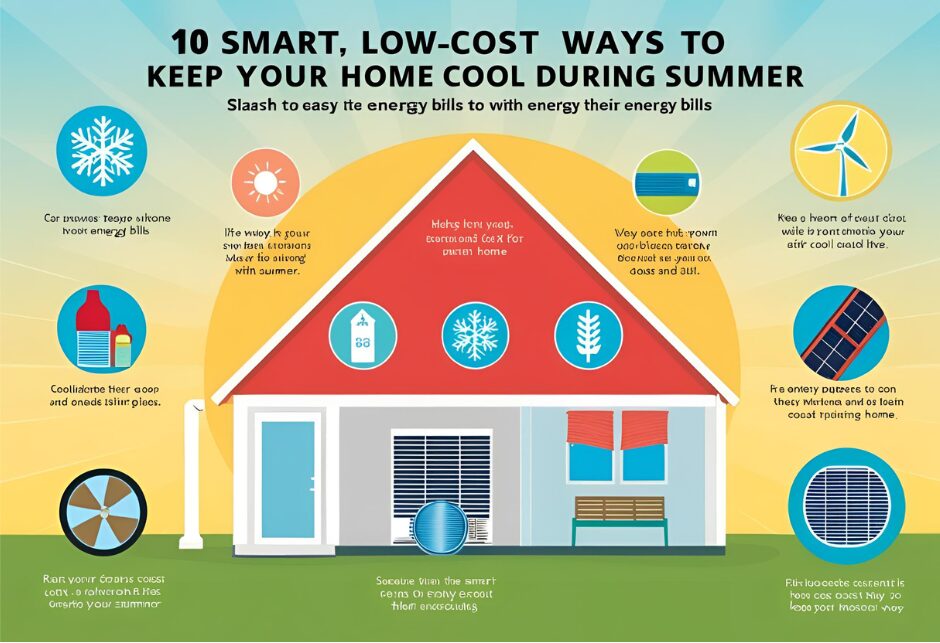
Stay cool without burning through your wallet—these practical tips help you beat the heat and save money at the same time.
As summer temperatures climb year after year, keeping your home comfortable becomes more challenging—and more expensive. Blasting the air conditioner 24/7 might feel like the only option, but it can quickly send your energy bill soaring.
The good news? You can stay cool and save money with a few strategic adjustments to your home and daily habits. Whether you’re working from home, raising a family, or simply trying to keep costs under control, here are 10 budget-friendly and energy-efficient ways to cool your house while lowering your AC costs.
1. Turn Up the Thermostat (Just a Little)
You don’t have to freeze indoors to stay comfortable. In fact, setting your thermostat just a few degrees higher can dramatically reduce energy consumption. The U.S. Department of Energy recommends setting your thermostat back 7–10°F for 8 hours a day to save up to 10% annually on your cooling costs.
💡 Pro tip: Try setting your thermostat to 75°F instead of 72°F and use fans to help circulate air. You’ll likely feel just as comfortable—and your wallet will thank you.
2. Upgrade to a Smart Thermostat
Smart thermostats are more than just convenient—they’re money-saving machines. These Wi-Fi-enabled devices let you schedule cooling cycles, adjust settings remotely, and even learn your preferences to optimize efficiency.
Some models use geofencing technology, automatically adjusting the temperature when you’re away. This small upgrade can reduce energy usage by up to 30%—plus, many insurance providers offer discounts for installing one.
3. Be Strategic About Thermostat Placement
Where your thermostat lives matters. If it’s installed near a sunny window, heat from the sun can cause false readings and unnecessary cooling. For better efficiency, install it in a central area away from direct sunlight and heat-producing appliances.
4. Avoid Using Heat-Generating Appliances Midday
Your oven, stove, and dryer all contribute to rising indoor temps. During peak heat hours, opt for alternatives like your microwave, air fryer, or outdoor grill.
🍳 Bonus: Cooking outside or preparing cold dishes like salads or smoothies also makes summer feel more enjoyable—and keeps your kitchen cooler.
5. Adjust Temperatures at Night
It’s easier to keep cool while sleeping thanks to lower outdoor temperatures. Pre-cool bedrooms in the evening, then increase the thermostat by 2–4°F while you sleep. You’ll stay comfortable and cut unnecessary energy use during the night.
6. Seal Windows and Block the Heat
Prevent cool air from leaking by locking your windows, using weather stripping, and drawing blinds or curtains—especially during the hottest parts of the day. Light-colored or thermal curtains help reflect sunlight and keep the heat out.
🌬️ If nights are cool in your region, open windows after sunset to let fresh air in, and close them in the morning to trap the coolness inside.
7. Maximize Natural Shade
Shading your windows—especially on the east, south, and west sides—can lower indoor temps by several degrees. Consider planting trees, adding awnings, or installing exterior shutters or reflective window film.
🌳 Pro tip: Deciduous trees (which lose leaves in winter) are ideal—they provide summer shade but let in sunlight during colder months.
8. Stop Air Leaks and Improve Insulation
Proper insulation isn’t just for winter. It keeps cool air in and hot air out. Check for gaps around doors, windows, and attic spaces, and seal them with caulk or weather stripping.
If you’re renovating, consider adding a high-performance house wrap to exterior walls—it’s one of the most efficient long-term investments for energy savings.
9. Maintain Your AC System
A neglected air conditioner works harder—and costs more. Change your air filter every 2–3 months (more often if you have pets), and schedule a yearly maintenance checkup with a professional.
🔧 A typical tune-up includes cleaning coils, checking refrigerant levels, and testing efficiency—all of which help your system run better and last longer.
10. Use Ceiling Fans to Circulate Air
Ceiling fans don’t cool the air, but they help your body feel cooler by promoting evaporation of sweat. Run them counterclockwise in the summer to create a breeze effect.
💡 Combine fans with a slightly higher thermostat setting to stay comfortable and reduce your reliance on AC.
Final Thoughts: Keep Cool, Save Big
You don’t need to sacrifice comfort to keep your energy bills low this summer. With a mix of smart tech, good habits, and a few budget-friendly upgrades, you can stay cool and eco-friendly—even during the hottest months of the year.
🌞 Want more smart home hacks to save energy year-round?
